Editorial
I'm writing this from a hotel room in Vancouver, BC, looking out at a lush, green (and wet) landscape. May has been a conference pig-out month for me, meaning a lot of time spent on the road (air, actually) and the remainder taken up with what seemed like a never ending stream of paper submission deadlines for others. With any luck, I'll have time for the shop in July, after I finish some CAD work for the bonus, mid-year, Members' free plan set. But for this month, the net result has been that I've hardly been home, let alone anywhere near the shop! But visiting BC has been good as it allowed me to get actually together with Adrian Duncan for a day.
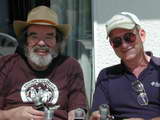
So here's the Vancouver Chapter of the Model Engine News Society for Engine Archaeology and Restoration (MENSEAR, not to be confused with PIGSEAR), sitting on Adrian's deck, fondling engines and enjoying some good Canadian sunshine and the occasional libation. This was a great chance to meet and discover that we both enjoy restoring "junkers" far more than buying a New In Box anything. Adrian was also able to show me something I'd only ever seen pictures of before: the OS Max 2.5cc BB diesel. I'm sure he now regrets this as he must now produce a review of it! Following this, he got me to the airport to catch the Alaska Air flight to LA where I found that my flight home had been cancelled due to strikes by Qantas maintenance engineers in Australia. Well, as they say, that which cannot be changed must be endured, so twelve hours later after a stay at the LAX Marriot as a "Distressed Passenger", Qantas finally delivered me home. And that, Dear Reader, is my excuse for missing the "first of the month" deadline for the first time ever. Sorry folks, but lacking airborne wireless LAN (it will come) there's nothing I could really do about it.
Also squeezed into May were the State C/L champs. I entered F2B aerobatics with a 20 year old Gieske Nobler (Fox 35, naturally) just to pad out the numbers. Well the wind came up in spades, the good fliers bowed out, and by the time the dust cleared, I found myself just 6 points behind the number one position and wishing I'd maybe put in an extra practice flight or twelve in the preceding weeks. But second is a lot more than I'd expected and now I'm thinking about a new stunter, and where the hell I could keep it if I build it! Hopefully the madness will pass without actual wood being cut, but on the other hand, if I build it, I'll have to find someplace to put it.
I'm uploading this on June 3 after arriving home late last night to torrential rain in Brisbane! The news this morning says we received twice the average June rainfall in 12 hours and wonder of wonders, enough seems to have fallen in the catchment that the dam levels may reach 40%, resulting in a relaxation of the "level 6" water restrictions. It's just a reprieve, not a cure, it's a most welcome one, nevertheless.
The DP Collection

In Last month's issue, we had a picture showing a display of early diesel engines by Darrel Peugh, taken at the MECA EXPO 2007. Darrel has a magnificent collection with many rare and unique engines from all over the world that you are just not going to see anywhere, for example this gear driven drum valve four-stroke. Rather than scatter them all over the place, a special page has been added to the Gallery that is reserved for items like this from his collection. You can reach it from the Gallery index page, or go direct to the Darrel Peugh Collection page using this link.
Another update to the Gallery is on the Roger Schroeder Tribute page. This is a MS 12 replica finished just this past month by Roger himself. Roger's example follows replicas built by Ken Croft and Les Stone, which is making others in our group think we should follow the example and build this ungainly but cute little engine. Roger's example has yet to run while he chases down spray-can ether to mix some fuel. If you are having trouble finding the "John Deere Starting Fluid", I'm told that the same company that makes "Thrust" starting fluid also makes one called "Instant" which has the same ether content as the Deere fluid and is available from Grainger for about $2.70 for an 11 ounce can. A description of a practical way to extract the ether from such cans has been added to the FAQ page.
Allouchery 0.7cc Replicas
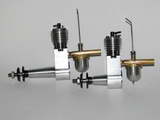
Motor Boy Eric Offen has been as busy as I've been slack, making long and short shaft replicas of the French Allouchery 0.7cc diesel using material he gleaned from drawings found in some of the Miguel de Rancougne Auction material that came his way. I've commented here several times before that building two examples of an engine is not a lot more work than building one, if you are smart about it. Well how smart is Eric? He made five of each! Read about it in Engine Gallery.
Ebenezer 08
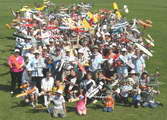
Long, long ago, and far, far away, Aeromodeller magazine published plans for a little all-sheet free-flight biplane that became an instant classic. The model is the Ebenezer and the designer is Texas Motor Boy, Bert Streigler. Bert's design has endured because it worked so well and allowed the builders to express their individuality: the Ebenezer Triplane, the Ebenezer canard, on, and on, and on... if it's all-sheet, flat airfoil and powered by a 0.5 to 0.75cc engine, it's and Ebenezer! For many years, Ebenezer fanatics have been gathering at Old Warden airfield in England for an annual fun day. This picture shows the 2008 turn-out: 154 by final count, even if the judges did decide to exclude the 400%, camera toting version because even though the airfoil was flat, it was built-up. But pushing the boundaries is all part of the fun (as should be bribing the judges  ). Bert's too humble to take due credit for all the fun his design has given so many, but I have no such reservations: Well done, Bert! You've achieved a deserved level of immortality through the Ebenezer that an awful lot of politicians think they have, but don't!
). Bert's too humble to take due credit for all the fun his design has given so many, but I have no such reservations: Well done, Bert! You've achieved a deserved level of immortality through the Ebenezer that an awful lot of politicians think they have, but don't!
ETA Drawings
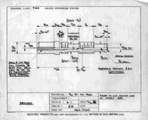
One of the great things about running this web site is the contact it provides with like minded modellers all over the world, many of whom buy the MEN ONLY DVD (hint, hint  ) and contribute to our collective enjoyment through photos, news, and obscure items found on the 'net. One in the latter category arrived by email from Member Greg Kamysz (USA) last month. Greg came across a New Zealand site that provides a bundle of scans taken of rescued, original drawings from the well remembered ETA engine range (see the ETA 5 and ETA 29 reviews for some historical background). The site link is here. It was put together by John Lichnerowicz from yellowed paper copies provided by Ian Mander. The spray bar shown above is an example and even though there are many drawings missing, just take a moment to think what a valuable resource this material will be to owners, restorers, and historians. More details on the material provenance are on the web site, the URL for which has been added to the MEN non-commercial links.
) and contribute to our collective enjoyment through photos, news, and obscure items found on the 'net. One in the latter category arrived by email from Member Greg Kamysz (USA) last month. Greg came across a New Zealand site that provides a bundle of scans taken of rescued, original drawings from the well remembered ETA engine range (see the ETA 5 and ETA 29 reviews for some historical background). The site link is here. It was put together by John Lichnerowicz from yellowed paper copies provided by Ian Mander. The spray bar shown above is an example and even though there are many drawings missing, just take a moment to think what a valuable resource this material will be to owners, restorers, and historians. More details on the material provenance are on the web site, the URL for which has been added to the MEN non-commercial links.
Massive Yet Tiny (MYT) Engine
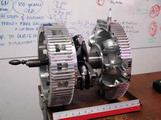
A reader from Colombia 'mailed with the URL of a new IC engine design with (and I quote) "...40 times higher power to weight ratio, low parts count, low maintenance, high mechanical efficiency, and low pollution...". The engine is the invention of Raphial Morgado and the suggestion is that the design might be the subject for a model. While the concept is fascinating, machining the parts in small scale would be a significant challenge—which is not to say it can't be done! The claims made for the engine are extraordinary, but worth looking at closely. Click the thumbnail picture to go to the web site (which has also been added to the Unusual Engine Sites section of the links page.
New Books and Magazines This Month
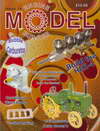
Issue #14 of Model Engine Builder arrived, a bit late, during May. In fact, editor Mike Rehmus names it as "...the last of the 2007 issues...finally[!]". I like that kind of honesty. Reasons, not excuses are offered, and the plan for 2008, or what's left of it, is announced. Starting from issue #15, MEB will contain a few more pages (#14 has 36 pages excluding covers and plan sheets). The increased size will go into build articles on steam and hot air engines. At the urging of the readership, tools and techniques will also get increased coverage. The number of loose plan sheets—seven double sided A3 sheets in #14—will also increase. As #14 is the "last for 2007", it includes an index for all issues since Issue #1 (which featured my own Mills 1.3 Mk I replica plans).
So, what's in issue #14? First is another of Jerry James' HEX series of Cox cylinder-based, multi-cylinder designs—this time a four cylinder in-line job. Malcolm Beak shows how to make a simple gasket punch for complex gaskets, and Tom Hare writes on doing the same job using a LASER cutter—and includes some very pragmatic observations on what you should expect to pay to have this done, even if you provide a CAD file of the job. Ron Cairns has another in his series on unorthodox IC engine designs, and Bob Washburn, editor and publisher of SIC provides the last part of a series on Albert Hutton (amen, please). There's more besides that, but I hope this gives you the drift of the content spread that Mike and Toni aim to provide in every issue. Do the math: even thought MEB authors are paid, a subscription is quite cheap. But without your support, the magazine can't exist. Then we'd be `back to occasional articles in much more expensive publications (end of un-paid commercial announcement).
Engine Of The Month: Nordec
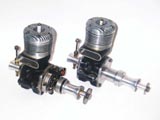
The subject this month is another rather obscure British product from the immediate post-WWII years called the Nordec. And if you think you see a passing resemblance to another 10cc "racing" engine from the other side of the Atlantic that was also sold in ignition and glow versions, you'd be quite correct as the Nordec has more than a passing similarity to the McCoy, right down to identical bore and stroke! So click the image or follow this link to the Adrian Duncan Nordec Review page.
Tech Tip of the Month
This month, we revisit the important topic of drill sharpening. Yes, I know, again... Previously, I've shown how those fortunate (or stubborn enough) to have completed a QUORN Tool and Cutter Grinder can do this using the four and six facet methods. The more common conical back-off method of relieving a twist drill tip results in what is termed a "chisel point" that is not a point at all. This works well enough, but tends to wander during entry. The faceted point is self-starting and will generally drill closer to nominal size. The downside is the extra effort and precision required to produce those facets.
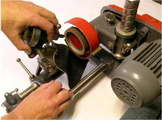
Recently, we received a description of an alternative approach developed by Jörg Hugel that shows some original thinking where the QUORN is used to produce conical back-off. The material has been around for some time and can still be downloaded from the Yahoo QUORN Users' Group, moderated by long time friend, Carl Carlsen (and visit the Groups Section of the Links page to see the other groups Captain Carl has brought together). Anyway, Jörg and Carl are happy for the PDF document describing Six Steps to the Perfect Drill with the Quorn Tool and Cutter Grinder to have yet another home. The PDF download has been added to the updated Drill Sharpening on the QUORN page (which I will complete, Real Soon Now).
Color CAD Survey
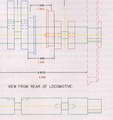
Last month, we asked readers to email if they had strong views one way or the other on the use of color in published engineering drawings. From the responses (23), we are all in furious agreement: color is definitely useful during the creative phase, but a negative when it comes to presentation in print, although there are valid exception cases such as double sided circuit board layouts—certainly doing it "just because we can" is about the worst reason imaginable. The "survey" responses reached double digits with only one thinking it was a good idea. We also agree that CAD is the way to go, though most truly appreciate the "artistry" inherent in pen and ink drawings of old and the use of different line "weights" alone to enhance plan readability. Points raised included the heigh prevalence of color blindness to varying degrees in the population, especially the aging male population, and guess where the majority of model engineers fall? I tried to be neutral in wording the RFI in the previous issue, but confess I chose just about the most offensive example of the offence for the graphic I could find. Now let's hope the editors are listening—I know at least one is preparing author guidelines that say drawings are to be black and white only, with the use of different line weights strongly encouraged.
 The DP Collection
The DP Collection
 Allouchery 0.7cc Replicas
Allouchery 0.7cc Replicas
 Ebenezer 08
Ebenezer 08
 ETA Drawings
ETA Drawings
 Massive Yet Tiny (MYT) Engine
Massive Yet Tiny (MYT) Engine
 Color CAD Survey
Color CAD Survey
 Editorial
Editorial
 New Books and Magazines This Month
New Books and Magazines This Month
 Engine Of The Month: Nordec
Engine Of The Month: Nordec
 Tech Tip of the Month
Tech Tip of the Month
 Standard Stuff
Standard Stuff





 ). Bert's too humble to take due credit for all the fun his design has given so many, but I have no such reservations: Well done, Bert! You've achieved a deserved level of immortality through the Ebenezer that an awful lot of politicians think they have, but don't!
). Bert's too humble to take due credit for all the fun his design has given so many, but I have no such reservations: Well done, Bert! You've achieved a deserved level of immortality through the Ebenezer that an awful lot of politicians think they have, but don't!





